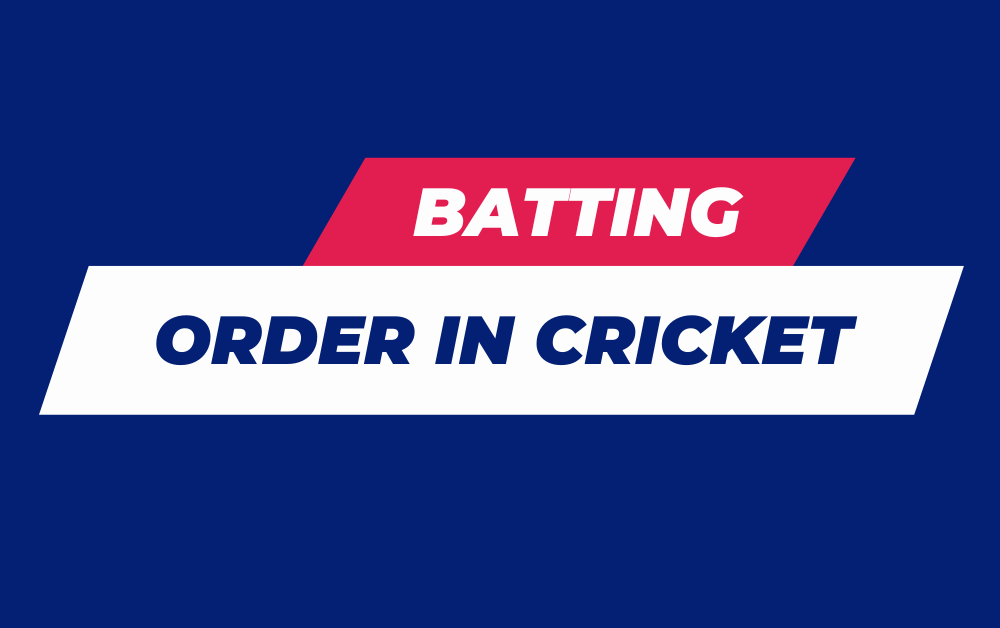Batting Order in Cricket: Art and Strategy Behind Lineup Decisions
Mastering the delicate balance between skills and situations
The batting order in cricket is crucial to how teams structure their innings. The sequence of batters balances skill sets and roles to maximize run scoring. This in-depth guide covers how batting orders are planned, batting positions, adapting strategies, and order philosophy between formats. Read on for an insider perspective on constructing cricket lineups.
Table of Contents
What is the Batting Order in Cricket?
The batting order refers to the official sequence in which batters enter play during an innings. The order is carefully planned by the team captain and coaches.
Batting positions range from the opening batters through the middle order to the tail-end. Each batting spot requires different skills and roles. Constructing a balanced lineup is an art that shapes match situations.
How is a Batting Order Determined in Cricket?
The main factors captains consider when determining the batting order are:
- Batting ability against pace and spin
- Power hitting capability
- Skill rotating the strike or finding boundaries
- Adaptiveness on different pitch types
- Experience batting with different partners
- Temperament when entering certain game situations
- Recent form and confidence
- Left/right hand combinations
- Bowling workloads of all-rounders
Using these inputs, the goal is building an order that maximizes run-scoring potential while preserving wickets.
What is the Typical Batting Order in Test Cricket?
While there is flexibility, a standard test batting order template is:
- Opening batsmen – numbers 1 & 2 are steady run accumulators who can handle the new ball and see off the opening bowlers. This lays the platform.
- First drop – number 3 is often the team’s best batter, adept at entering when conditions are still bowler-friendly and excelling through the innings phases.
- Middle order – numbers 4 to 6 balance aggression with consolidation to build big totals. They cash in when the ball softens up.
- Wicketkeeper – usually bats number 7, offering another specialist batting option.
- All-rounders – typically occupy numbers 8 and 9, contributing lower order runs and balancing the workload.
- Bowlers – the final bowlers slot in at numbers 10 and 11 to add late runs.
So the order transitions smoothly between nailing the basics to explosive hitting.
How Does Batting Order Strategy Differ in Limited Overs Cricket?
Batting orders in ODI and T20 cricket evolved to utilize power hitting and attack from ball one. Key limited overs tactics are:
- ‘Pinch hitters’ who open and attack while fielding restrictions apply, even if they only bat a few overs.
- Less reliance on ‘anchors’ who accumulate slowly and more all-round aggression.
- Slower building partnerships – quick high scores and preserving wickets both vital.
- Lower order hitting maximized with specialist power strikers instead of bowlers.
- Left-right hand partnerships for gap hitting.
So limited overs rewards planning orders to maximize boundary options at all phases with extreme aggression.
Why do Teams Change the Batting Order in Cricket?
Captains will adapt their batting lineup during a match or series to:
- Account for injuries and call-ups – replacements rarely slot into the exact same spot.
- Manage player fatigue and workloads across repeated games.
- Counter particular bowling threats and conditions.
- Change momentum after batting collapses.
- Exploit favorable match situations – e.g. batting deeper with a lead or earlier if chasing.
- Unleash a ‘pinch hitter’ when quick runs are urgent.
- Shield weaker batters by separating them with in-form players.
So while consistency creates stability, smart batting orders are always tuned to match context.
How Does Shot Selection Differ Across Batting Positions?
The types of shots and batting methods vary through the order:
- Opening batters favor patient, low risk strokes to see off the new ball – leave well, play straight, occasional cuts and pulls.
- The top order focus on traditional batting orthodoxy – forward defense and driving through the line feature highly.
- Middle order batters play more aggressive cross-bat shots like sweep/pull to up the run rate.
- Lower order players must up the attacking intent and play improvised ‘slog’ shots or aerial drives. Playing shots deemed higher risk earlier in the innings.
So shot selection morphs from cautious to ultra-aggressive down the order.
What is the Role of a ‘Pinch Hitter’ in Batting Orders?
A ‘pinch hitter’ is a tactical wildcard option captains use, typically in ODI and T20 cricket.
It involves promoting big hitters with license to attack up the order when urgent runs are required during a chase or late innings push. Their ultra-aggressive approach sacrifices defense for rapid scoring.
The pinch hitter aims to capitalize during fielding restrictions by taking high-risk boundaries. If they fall cheaply, the regular order batsman just comes in next.
Used sparingly when the match situation demands, a pinch hitting maverick can transform games with a quickfire cameo at the top.
How Do Teams Manage the Late Loss of a Wicket?
Losing a wicket just before a break in play presents teams with a dilemma – whether to expose a specialist batter early or send in a ‘nightwatchman’.
A nightwatchman is usually a tailender promoted up the order specifically to shield recognized batters during the high-risk final overs of the day. Their job is to survive and spare the specialists having to enter a tricky period.
While conservative, nightwatchmen exemplify how batting orders always respond dynamically to within-match situations.
Dissecting the Lineup: A 10-Question Deep Dive
- The Top Order Enigma: Numbers 1, 2, and 3. The gladiators facing the new ball, the foundation upon which an innings must be built. But who takes these hallowed positions? Does a captain prioritize aggressive strokemakers or rock-solid defenders? Are technical prowess and temperament equally important?
- The Unsung Heroes: Demystifying the Middle Order: Numbers 4 to 6. They inherit the battle after the initial storm, often facing seasoned bowlers and a shifting game state. Are they masters of adapting to situations, playing anchors when needed, or explosive finishers waiting to unleash?
- The Tailenders: More Than Just a Number: Numbers 7 to 11. Often seen as the weakest link, they hold the key to unexpected fightbacks and nail-biting finishes. Does their role extend beyond simply protecting the wicket? Can their unexpected skills turn the tide of a match?
- Strategy or Serendipity? The Art of Choosing the Order: What factors shape a captain’s decision? Is it simply picking the best batsmen in form? Or are there deeper calculations at play, considering match conditions, bowler matchups, and even psychological warfare?
- Adapting to Formats: The Chameleon Batting Order: Test matches, ODIs, T20s – each format demands a unique approach. Does the batting order morph like a chameleon, adjusting to the constraints of time and overs? What strategies shine in each format, and how do they differ?
- Dynamic Twists: When the Script Gets Flipped: Injuries, tactical gambles, even a gut feeling – can the batting order change mid-innings? What are the “pinch hitters” and “nightwatchmen” of the cricket world, and when are they deployed?
- History Speaks: Lessons from the Legends: From Bradman’s dominance to Dhoni’s finishing masterclass, batting orders have shaped cricket’s greatest moments. What can we learn from the strategies of the past, and how do they influence the present?
- Technology’s Touch: Data-Driven Decisions? In the age of analytics, does batting order selection become a mathematical equation? Do statistical models and performance trends play a role in choosing the lineup?
- The Human Factor: Beyond Numbers and Charts: Can captain’s intuition and gut feeling still override data and algorithms? How does leadership, understanding individual players’ moods and mental states, factor into the selection process?
- The Future Beckons: Evolving Batting Orders: As cricket continues to evolve, will the batting order remain a constant, or will we see radical changes to reflect new playing styles and formats? What innovations might the future hold for this timeless strategic element?
Remember These Key Points:
- The batting order is a strategic tool for captains to utilize a team’s batting strengths and adapt to match conditions.
- Different roles exist within the order, from aggressive openers to resilient middle-order batsmen and unpredictable tailenders.
- Formats like Test matches, ODIs, and T20s demand different approaches to batting order selection.
- The order can be flexible, with changes mid-innings based on tactical needs and unexpected situations.
- Technology and data analysis play an increasing role in batting order decisions, but the human element remains crucial.
So, the next time you witness a cricketer stride out to the crease, remember that it’s not just an individual facing the bowler. It’s a carefully calculated move within a grander scheme, a chapter in the story woven by the batting order. Dive deeper, understand its nuances, and appreciate the subtle art of building an innings, one willow at a time.
Conclusion – An Ever-Evolving Puzzle
Setting the batting order is a multifaceted puzzle requiring balance between continuity and adaptability. Different eras and formats produce new theories – formulas keep evolving with white ball aggression now prioritized. But the essence remains recognizing the right skills for the situation. A solid batting strategy empowers individuals to shine within the lineup. That alchemy makes batting orders endlessly captivating.
Read more About the Live Cricket Streaming on Webcric!
With Webcric, fans can enjoy their favorite matches from the comfort of their homes or on the go.

Embrace the live streaming experience and enjoy the matches!







